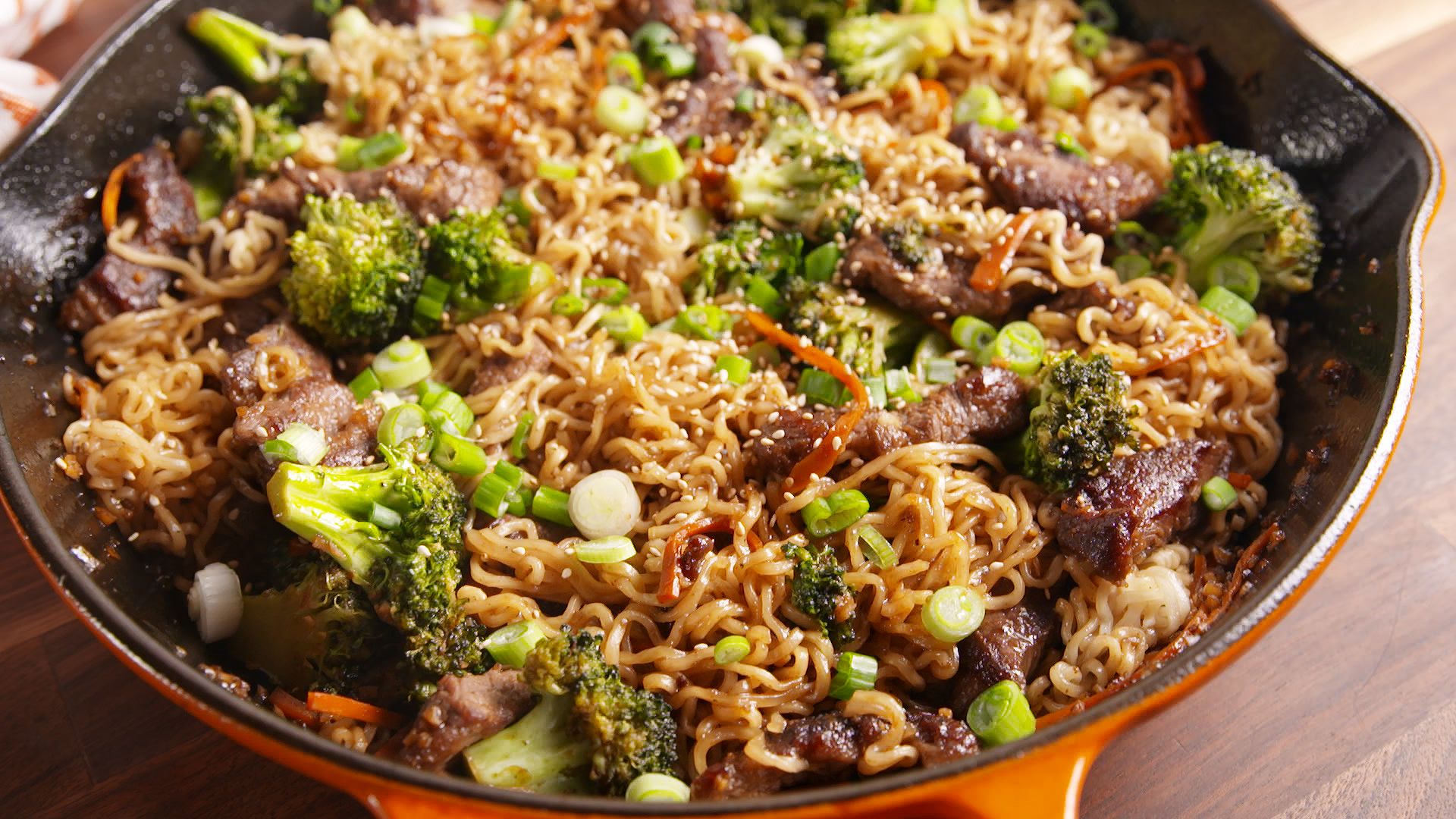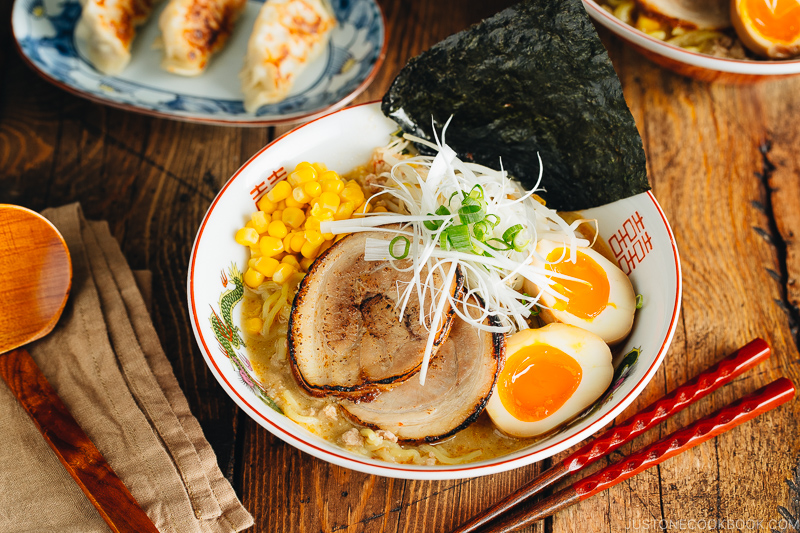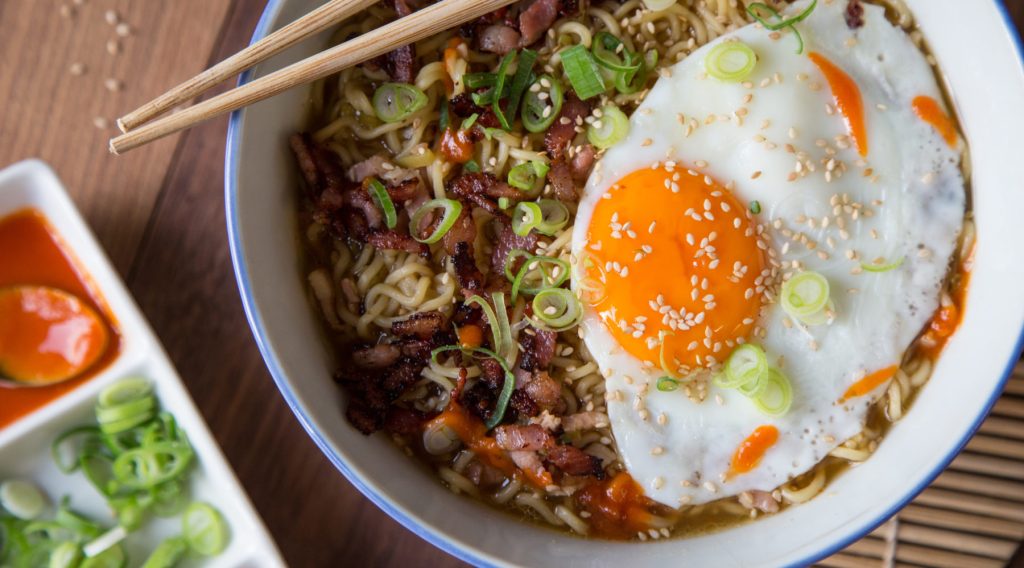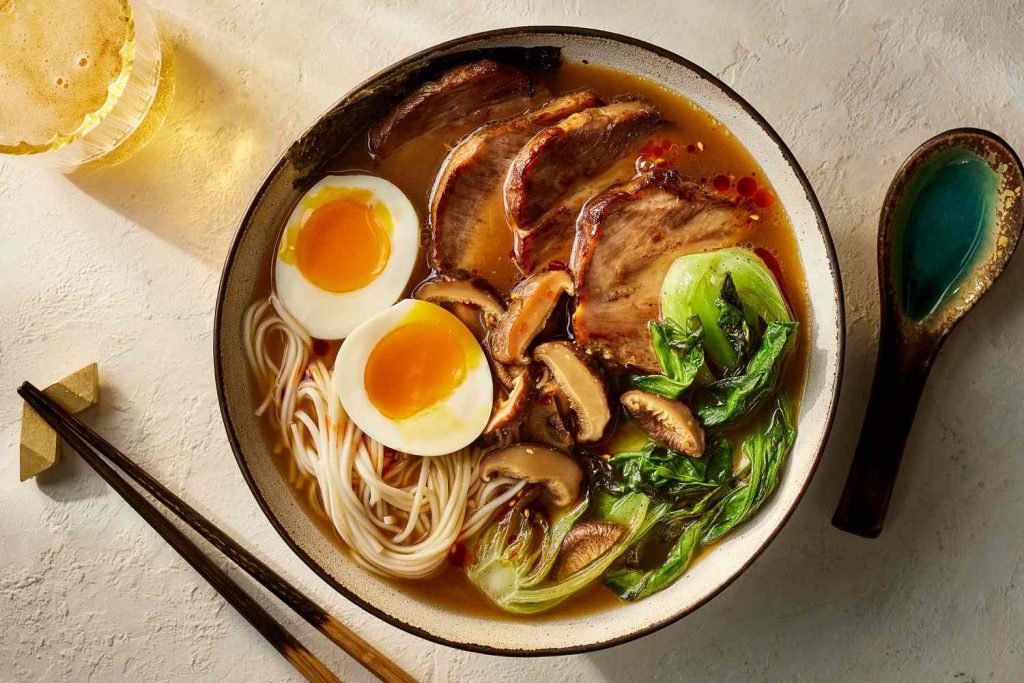Japanese Mongolian Beef Ramen is a tantalizing fusion dish that brings together the bold flavors of Mongolian beef and the comforting elements of Japanese ramen. This delightful culinary creation combines tender strips of beef, marinated in a savory sauce, with a steaming bowl of ramen noodles, a flavorful broth, and an array of delicious toppings. The result is a dish that harmoniously blends the robust and sweet notes of Mongolian cuisine with the rich umami flavors of Japanese ramen, offering a truly satisfying and memorable dining experience. Get ready to embark on a culinary journey that merges the best of both worlds and indulge in the tantalizing flavors of Japanese Mongolian Beef Ramen.

Japanese Mongolian Beef Ramen Recipe
Equipment
- 1 pan
Ingredients
- 2 tbsp Nori paste
- 1/2 cup Sliced green onions
- 1 tsp Mirin paste
- 1 tsp Fresh ginger
- 1 tbsp Miso paste
- 1 cup Beef meat pieces
- 1 tbsp Soy sauce
- 2 tbsp Mongolian spice
- 2 tsp Olive oil
- 1 tsp Chopped garlic
- 1/2 tsp Japanese fresh herbs
- 2 tsp Fresh shiso leaves
- 1/2 cup Fresh cilantro leaves
- 1/2 cup Chopped tomatoes
- Ramen, as required
Instructions
- Add the beef pieces into a pan.
- Add the Mongolian spice and olive oil into the pan.
- Cook the beef pieces for ten minutes or until they are completely cooked.
- Dish out the beef pieces and shred them when cooled.
- Take a large sauce pan.
- Add all the ingredients of the sauce into the pan.
- Add the shredded beef meat, nori paste, chopped tomatoes and the rest of the ingredients into the mixture.
- Cook the dish for ten minutes.
- Add the ramen into the mixture once the sauce is ready.
- Mix the ramen well.
- Cook the dish for five minutes.
- Add the green onions into the dish.
- . Your dish is ready to be served.
Video
Notes
FAQs
Here are some frequently asked questions (FAQs) about Japanese Mongolian Beef Ramen:
1. What is Mongolian beef?
– Mongolian beef is a popular dish in Chinese-American cuisine. It typically consists of thinly sliced beef that is stir-fried with a sweet and savory sauce, often made with soy sauce, garlic, ginger, brown sugar, and hoisin sauce. In the context of Japanese Mongolian Beef Ramen, the Mongolian beef component adds a unique flavor profile to the dish.
2. Can I use other cuts of beef for Mongolian beef?
– Yes, you can use various cuts of beef for Mongolian beef. Traditionally, flank steak or sirloin are popular choices due to their tenderness and flavor. However, you can also use other cuts like ribeye or strip loin. The important thing is to slice the beef thinly against the grain to ensure it cooks quickly and remains tender.
3. Can I make the Mongolian beef ahead of time?
– Yes, you can prepare the Mongolian beef ahead of time. After stir-frying the beef, allow it to cool down and store it in an airtight container in the refrigerator. When you’re ready to serve the ramen, simply reheat the beef in a pan or microwave before assembling the bowls.

4. Can I use pre-packaged ramen noodles for this recipe?
– While pre-packaged ramen noodles can be used as a convenience option, they may not offer the same quality and texture as fresh or dried ramen noodles. For the best experience, consider using fresh ramen noodles from an Asian grocery store, or alternatively, dried ramen noodles specifically labeled for ramen dishes.
5. Can I adjust the spiciness level of the ramen broth?
– Absolutely! If you prefer a spicier ramen broth, you can add chili oil, chili flakes, or sriracha sauce to the broth while simmering it. Adjust the amount according to your preferred level of spiciness. Remember to taste and adjust the seasoning as needed.
6. Can I make the ramen broth ahead of time?
– Yes, you can prepare the ramen broth ahead of time. Allow it to cool down and store it in the refrigerator. When you’re ready to serve, gently reheat the broth on the stovetop until it’s hot, and adjust the seasoning if necessary.
7. Can I customize the toppings in Japanese Mongolian Beef Ramen?
– Absolutely! Toppings are a great way to personalize your ramen. You can add traditional toppings like sliced green onions, bean sprouts, bamboo shoots, or nori seaweed. Additionally, you can include other ingredients such as soft-boiled eggs, corn kernels, mushrooms, or even fresh herbs like cilantro or Thai basil.
8. Can I make a vegetarian or vegan version of this dish?
– Yes, you can adapt this recipe to suit a vegetarian or vegan diet. Instead of beef, you can use plant-based alternatives such as tofu or seitan as a substitute. For the broth, you can use vegetable broth or mushroom broth as a flavorful base. Be sure to choose vegan-friendly sauces and condiments for the marinade and broth.
9. Can I adjust the sweetness level of Mongolian beef?
– Yes, you can adjust the sweetness level of the Mongolian beef by adding more or less sugar or using alternative sweeteners like honey or maple syrup. Taste the sauce as you cook and adjust the sweetness according to your preference.
10. Can I make Japanese Mongolian Beef Ramen gluten-free?
– Yes, you can make this dish gluten-free by using gluten-free soy sauce or tamari in the Mongolian beef marinade and choosing gluten
Cooking tips
Here are some cooking tips to help you prepare Japanese Mongolian Beef Ramen:
1. Thinly slice the beef: To ensure tender and quick-cooking beef, slice it thinly against the grain. This helps to break down the muscle fibers and results in a more tender texture.
2. Marinate the beef: Marinating the beef in the Mongolian sauce helps to infuse it with flavor and tenderize the meat. Allow the beef to marinate for at least 15-30 minutes, or longer if time permits, to enhance its taste.
3. Preheat the pan or wok: When stir-frying the beef, make sure to preheat the pan or wok over high heat before adding the oil. This allows for quick and even cooking, ensuring that the beef gets nicely seared and locks in the flavors.
4. Stir-fry in batches: To achieve proper browning and avoid overcrowding the pan, it’s best to stir-fry the beef in small batches. Overcrowding the pan can cause the beef to steam instead of sear. Cook each batch of beef until it is browned and cooked to your desired level of doneness.
5. Don’t overcook the beef: Since the beef is thinly sliced, it cooks quickly. Be mindful not to overcook it, as it can become tough and chewy. Stir-fry the beef just until it’s cooked through, and remove it from the heat promptly.

6. Prepare the ramen noodles just before serving: For the best texture and flavor, cook the ramen noodles just before you’re ready to assemble the bowls. Overcooked or sitting noodles can become mushy or lose their firmness.
7. Customize the toppings: Feel free to experiment with various toppings to enhance the flavor and visual appeal of your ramen. Fresh herbs like cilantro or Thai basil, thinly sliced vegetables, and even a soft-boiled egg can elevate the dish.
8. Adjust the seasoning: Throughout the cooking process, taste and adjust the seasoning of both the Mongolian beef and the ramen broth. Everyone’s preference for sweetness, saltiness, and spiciness may differ, so trust your taste buds and make adjustments accordingly.
9. Serve hot: Ramen is best enjoyed piping hot. Serve the Japanese Mongolian Beef Ramen immediately after assembling the bowls to ensure that the noodles, beef, and broth are at their optimal temperature.
10. Enjoy it with chopsticks and a spoon: Embrace the authentic experience by using chopsticks to pick up the noodles and beef, and a spoon to sip the delicious broth. This allows you to savor every element of the dish.
Remember, cooking is an adventure, so feel free to experiment and make adjustments to suit your personal taste preferences. Enjoy the process and the delightful flavors of Japanese Mongolian Beef Ramen!
Serving Suggestions
Here are some serving suggestions for Japanese Mongolian Beef Ramen:
1. Individual Ramen Bowls: Serve the Japanese Mongolian Beef Ramen in individual bowls, allowing each person to enjoy their own customized bowl of goodness. Start with a generous portion of ramen noodles at the bottom, top it with the Mongolian beef, and ladle the hot broth over it. Garnish with fresh herbs, such as cilantro or green onions, and a sprinkle of sesame seeds for added visual appeal.
2. Family-Style Platter: For a casual gathering or family-style meal, you can present the components of Japanese Mongolian Beef Ramen on a large platter or in separate serving bowls. Arrange the cooked ramen noodles, Mongolian beef, and toppings attractively. Place the hot broth in a large serving pot or bowl on the side. Each person can then assemble their own bowl according to their preferences.
3. Add a Side of Steamed Vegetables: Enhance the nutritional value and add vibrant colors to the meal by serving a side of steamed vegetables alongside the Japanese Mongolian Beef Ramen. Vegetables like bok choy, snow peas, or broccoli florets work well and provide a refreshing contrast to the rich flavors of the ramen.
4. Pair with Japanese-inspired Appetizers: Begin the meal with some delicious Japanese-inspired appetizers to complement the flavors of the ramen. Options could include gyoza (dumplings), edamame, seaweed salad, or Japanese-style cucumber salad. These appetizers will help to create a well-rounded and satisfying dining experience.

5. Offer a Variety of Condiments: Set up a condiment station with a variety of toppings and seasonings for guests to customize their ramen bowls. Include condiments like soy sauce, chili oil, sesame oil, sriracha sauce, or Japanese seven-spice blend (shichimi togarashi). This allows everyone to adjust the flavors and spice levels according to their preferences.
6. Serve with a Side of Japanese Pickles: Japanese pickles, known as tsukemono, make a wonderful accompaniment to ramen. The tangy and crunchy pickles provide a refreshing contrast to the rich and savory flavors of the dish. Include a selection of pickles such as takuan (pickled daikon radish) or shibazuke (pickled cucumbers with purple shiso leaves).
7. Offer a Variety of Protein Options: While Mongolian beef is the featured protein in this recipe, you can provide alternative protein options to cater to different dietary preferences. Consider offering cooked and sliced chicken, tofu, or shrimp as additional protein choices. This allows guests to customize their bowls and enjoy the ramen according to their liking.
8. Pair with Japanese Green Tea: For an authentic Japanese dining experience, consider serving Japanese green tea alongside the Japanese Mongolian Beef Ramen. The subtle and refreshing flavors of green tea complement the rich and savory flavors of the dish, providing a balanced and enjoyable pairing.
Remember to provide serving utensils, chopsticks, and spoons for easy enjoyment of the ramen. Encourage guests to mix and match the ingredients, explore different flavor combinations, and savor the unique fusion of Mongolian beef and Japanese ramen.








